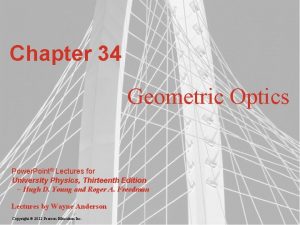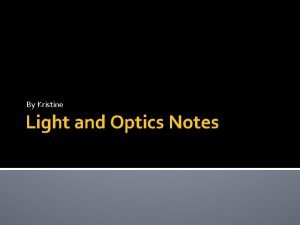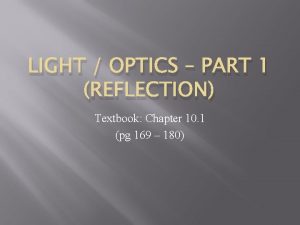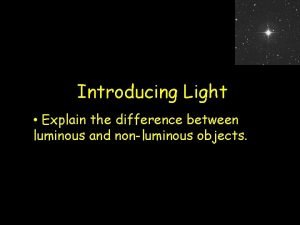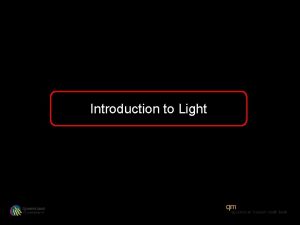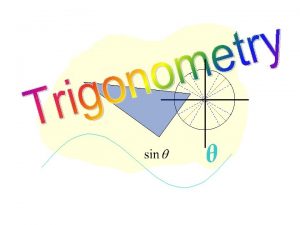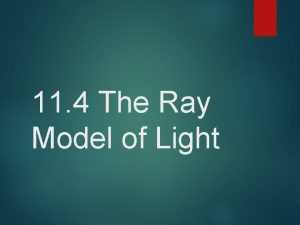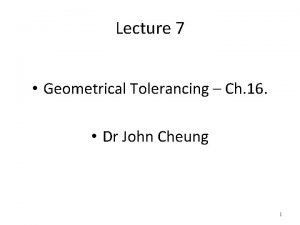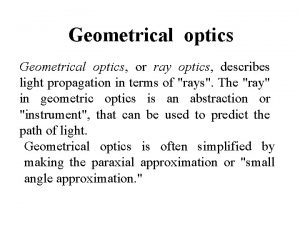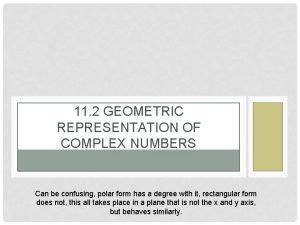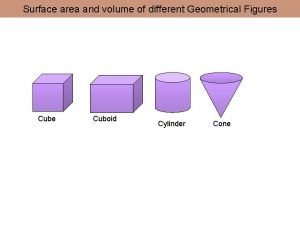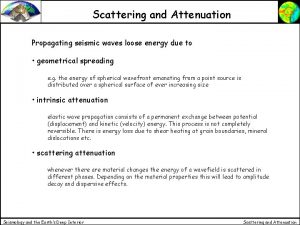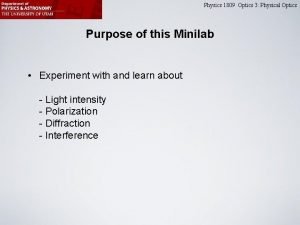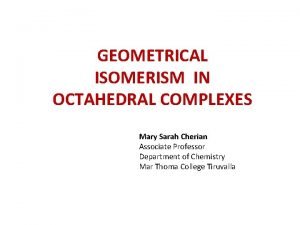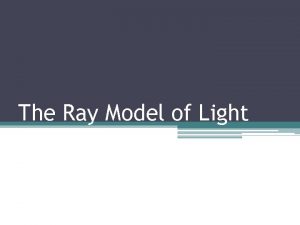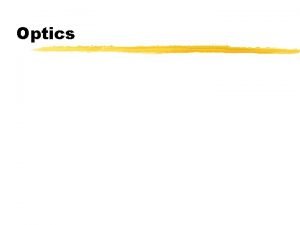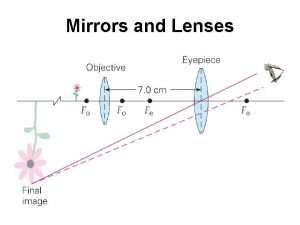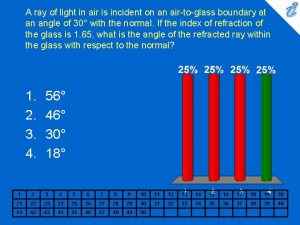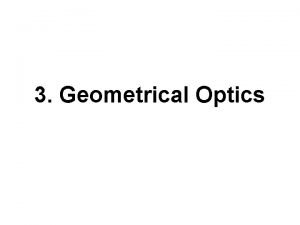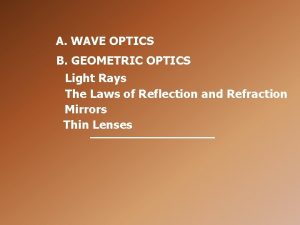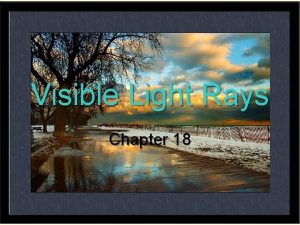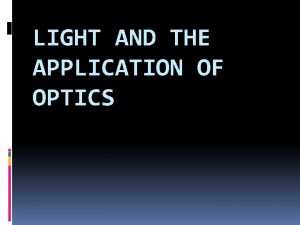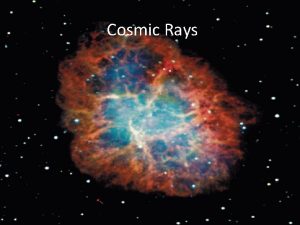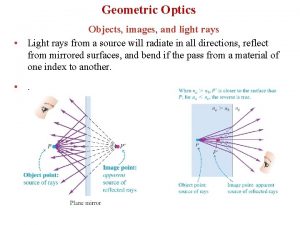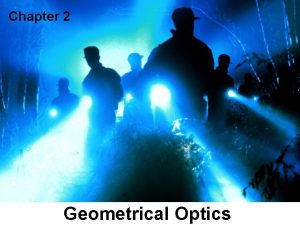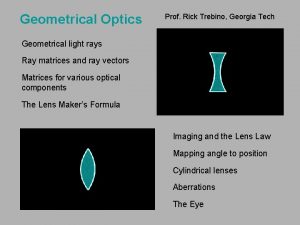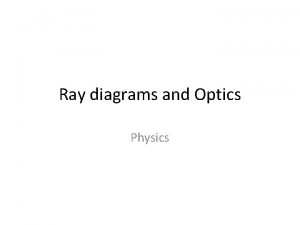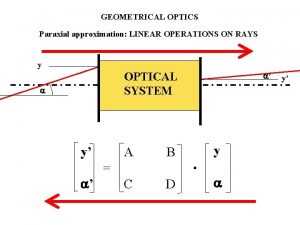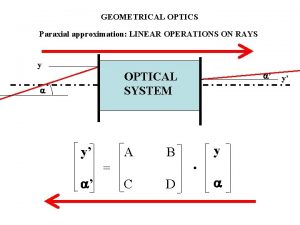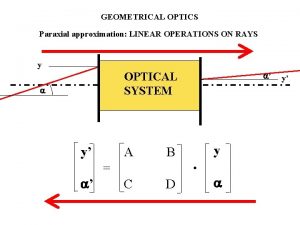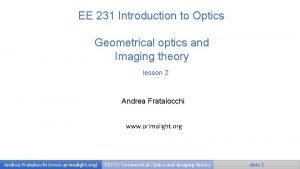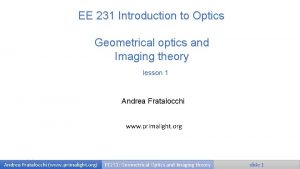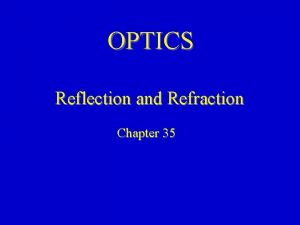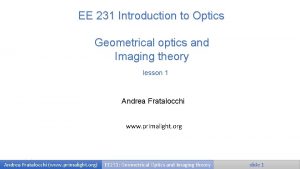Geometrical Optics Geometrical light rays Ray matrices and




















![Ray matrix for a curved interface [radius R ] At the interface, again: xout Ray matrix for a curved interface [radius R ] At the interface, again: xout](https://slidetodoc.com/presentation_image_h2/470fd8d321323bdb56f28737ffb1b69f/image-21.jpg)















- Slides: 36

Geometrical Optics Geometrical light rays Ray matrices and ray vectors Matrices for various optical components The Lens Maker’s Formula Imaging and the Lens Law Mapping angle to position 1

Leerdoelen In dit college leer je: • Wat de benaderingen zijn van geometrische optica • Wat de belangrijkste karakteristieken van lenzen zijn • Hoe je de stralengang door optische systemen met o. a. lenzen kunt analyseren • Een matrix-methode voor geometrische optica • Toepassing: microscopie, fotografie en bijbehorende eigenschappen • Hecht: 5. 1 t/m 5. 4; 5. 7; 6. 1 en 6. 2 2

Three Models of Light Photons Rays Waves The waves are all centered on the light source. The rays all move away from the source -> The wavefronts are perpendicular to the rays.

Is geometrical optics the whole story? No. We neglect the wave nature of light. ~0 Also, our ray pictures seem to imply that, if we could just remove all aberrations, we could focus a beam to a point and obtain infinitely good spatial resolution. Not true! The smallest possible focal spot is the on the order of the wavelength l. Same for the best spatial resolution of an image. This is due to diffraction, which is not included in geometrical optics. ≈l 4

Arguments in favor of geometrical optics Remember week 1 in which we discussed three reasons to believe that the ray picture of light is useful: 1. The straight propagation of light that we see entering through a window. 2. The camera obscura in which a small aperture produces an image that is upside down. 3. The very narrow beams that are produced by a laser. 5

Relation between object, image and focus Gauss Law f Magnification: f 6

Lensmaker’s formula 9

Types of lenses Lens nomenclature: Which type of lens to use (and how to orient it) depends on the aberrations (next lecture) and application. 10

Sign convention for R 11

Tracing a few rays (Fig 5. 20 Hecht) • Rays through the center of the lens go straight • Parallel rays from the object pass through Fi • Rays through Fo propagate parallel to the axis behind the lens 12

Image formation by a thin lens • • The image is formed at the point where these rays cross A real image is formed if s 0 > f The magnification of the image is given by Mt For a single, positive lens, the magnification will be negative 13

Virtual Images A virtual image occurs when the outgoing rays from a point on the object never actually intersect at a point but can be traced backwards to one. Negative-f lenses have virtual images, and positive-f lenses do also if the object is less than one focal length away. Virtual image Object infinitely far away Object f<0 Simply looking at a flat mirror yields a virtual image. f>0 14

Combination of 2 lenses spaced < F 1, F 2 15

Ray Optics axis We'll define light rays as directions in space, corresponding, roughly, to k-vectors of light waves. We won’t worry about the phase. We also ignore reflections. Each optical system will have an axis, and all light rays will be assumed to propagate at small angles to it. This is called the Paraxial Approximation: sin q tan q q 16

The Ray Vector xin , qin xout, qout A light ray can be defined by two coordinates: its position, x y l ra optica its slope, q q x Optical axis These parameters define a ray vector, which will change with distance and as the ray propagates through the optical elements. 17

Ray Matrices For many optical components, we can define 2 x 2 ray matrices. An element’s effect on a ray is found by multiplying this matrix with the ray vector. Optical system ↔ 2 x 2 Ray matrix Ray matrices can describe simple and complex systems. These matrices are often (uncreatively) called ABCD Matrices. 18

Physical meaning of two of the matrix elements spatial magnification angular magnification 19

For cascaded elements, we simply multiply ray matrices. O 1 O 2 O 3 Notice that the order looks opposite to what it should be, but it makes sense when you think about it. 20

Ray matrix for free space or a medium If xin and qin are the position and slope upon entering, let xout and qout be the position and slope after propagating from z = 0 to z. xout qout Xin, qin Rewriting these expressions in matrix notation: z=0 z 21

Ray Matrix for an Interface At the interface, clearly: qin xout = xin n 1 Now calculate qout. Snell's Law says: qout xout n 2 n 1 sin(qin) = n 2 sin(qout) which becomes for small angles: n 1 qin = n 2 qout = [n 1 / n 2] qin 22
![Ray matrix for a curved interface radius R At the interface again xout Ray matrix for a curved interface [radius R ] At the interface, again: xout](https://slidetodoc.com/presentation_image_h2/470fd8d321323bdb56f28737ffb1b69f/image-21.jpg)
Ray matrix for a curved interface [radius R ] At the interface, again: xout = xin. To calculate qout, we must calculate q 1 and q 2. If qs is the surface slope at the height xin, then R qs q 2 q 1 qin xin n 1 z=0 qout qs z qs = xin /R n 2 z q 1 = qin+ qs and q 2 = qout+ qs q 1 = qin+ xin / R and q 2 = qout+ xin / R Snell's Law: n 1 q 1 = n 2 q 2 23

A thin lens is just two curved interfaces: We’ll neglect the glass in between (it’s a really thin lens!), and we’ll take n 1 = 1. R 1 n 1=1 R 2 n 2≠ 1 n 1=1 This can be written: where: The Lens-Maker’s Formula Next: justify that f = focal length 24

Ray matrix for a lens The quantity f, is the focal length of the lens. It’s the most important parameter of a lens. It can be either positive or negative. R 1 > 0 R 2 < 0 f>0 If f > 0, the lens deflects rays toward the axis. R 1 < 0 R 2 > 0 f<0 If f < 0, the lens deflects rays away from the axis. 25

A lens focuses parallel rays to a point one focal length away. A lens followed by propagation by one focal length: free space lens f f For all rays xout = 0! Assume all input rays have qin = 0 At the focal plane, all rays converge to the z axis (xout = 0) independent of input position, with angle –xin/f. [Parallel rays at a different angle focus at a different xout. ] Notice we have now proven the Lensmakers’ Law. 26

Concave Spherical Mirror A concave mirror A radio telescope Like a lens, a curved mirror will focus a beam. Its focal length is R/2, with R the radius of curvature. 27

Ray Matrix for a Curved Mirror Consider a mirror with radius of curvature, R, with its optic axis perpendicular to the mirror: R qout qs qin q 1 xin = xout z Like a lens, a curved mirror will focus a beam. Its focal length is R/2. Note that a flat mirror has R = ∞ and hence is described by an identity ray matrix. 28

Consecutive lenses Suppose we have two lenses right next to each other (with no space in between). f 1 f 2 So two consecutive lenses act as a single lens whose focal length is computed by the inverse sum. As a result, we define a measure of inverse focal length, the diopter. 1 diopter = 1 m -1 29

A system images an object when B = 0. When B = 0, all rays from a point xin arrive at a point xout, independent of their angle: xout = A xin When B = 0, A is the magnification. 30

The Lens Law From the object to the image, we have: 1) A distance do 2) A lens with focal length f 3) A distance di This is the Lens Law, due to Gauss. 31

Imaging Magnification If the imaging condition, is satisfied, then: So: 32

Microscopes Image plane #1 Objective M 1 Eyepiece Image plane #2 M 2 Microscopes basically consist of a set of lenses, and: 1. In a microscope, the object is really close and we wish to magnify it. 2. Lens aberrations should be minimized (next lecture). A microscope is effectively a telescope in reverse. The goal is to magnify the object, not its angular diameter. The microscope objective yields a magnification of from 5 to 100, corresponding to focal lengths of 40 mm to 2 mm. The eyepiece yields a magnification of 2 to 10, corresponding to various focal lengths and distances. Eyepiece Objective 33

Microscope Terminology 34

F-number The F-number, “f / #”, of a lens is the ratio of its focal length and its diameter. f/# = f/d Confusing!! For example, a lens with a 25 mm aperture and a 50 mm focal length has an f-number of 2, which is usually designated as f/2 f d 1 f f d 2 f/# =1 f f/# =2 Small f-number lenses collect more light but are harder to engineer. 35

Depth of Field Only one plane is imaged (i. e. , is in focus) at a time. But we’d like objects near this plane to at least be almost in focus. The range of distances in acceptable focus is called the depth of field. It depends on how much of the lens is used, that is, the aperture. Out-of-focus plane Object f Aperture Image Size of blur in out-of-focus plane Focal plane The smaller the aperture, the greater the depth of field. 36

Depth of field example A large depth of field isn’t always desirable. f/32 (very small aperture; large depth of field) f/32 means f/D = 32, the focal length of the lens is 32 times larger than the aperture diameter f/5 (relatively large aperture; small depth of field) A small depth of field is also desirable for portraits. 37

Tot slot Wat hebben we gezien: • Geometrische optica • Berekeningen met lenzen • ABCD-matrix voor optische systemen • Matrix-berekeningen in geometrische optica • Inleiding in microscopie 38
 Difference between ray optics and wave optics
Difference between ray optics and wave optics Geometric optics ppt
Geometric optics ppt Geometrical
Geometrical Venn diagram of geometric optics and physical optics
Venn diagram of geometric optics and physical optics Light and optics notes
Light and optics notes Bill nye light and optics
Bill nye light and optics Bill nye light optics worksheet
Bill nye light optics worksheet Difference between luminous and non luminous
Difference between luminous and non luminous Light light light chapter 23
Light light light chapter 23 Light light light chapter 22
Light light light chapter 22 Chapter 22
Chapter 22 Materials that can block light
Materials that can block light Introduction of light
Introduction of light Colorter
Colorter Unit circle tan
Unit circle tan Ray tracing and ray casting
Ray tracing and ray casting Ray model of light
Ray model of light Gd and t symbols
Gd and t symbols Structural vs geometric isomers
Structural vs geometric isomers Geometrical tolerance
Geometrical tolerance Geometrical tolerancing
Geometrical tolerancing Geometrical
Geometrical Geometrical
Geometrical Geometric representation of complex numbers
Geometric representation of complex numbers Volume of geometrical figures
Volume of geometrical figures Geometrical spreading
Geometrical spreading Geometrical shadow
Geometrical shadow Define geometrical isomerism
Define geometrical isomerism When light travels from an optically denser medium
When light travels from an optically denser medium Name the two parts that make up most mirrors.
Name the two parts that make up most mirrors. The ray model of light says
The ray model of light says Mirror and lens equation
Mirror and lens equation A ray of light in glass is incident on a boundary with air
A ray of light in glass is incident on a boundary with air Transparent ray model
Transparent ray model The ray model of light
The ray model of light Light frequency spectrum
Light frequency spectrum Warming ray of light
Warming ray of light

